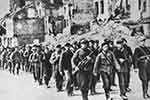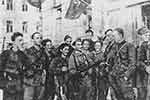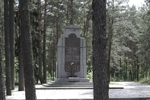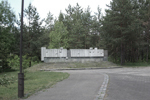The Partisans of Vilna Liberate their City
"The things I saw beggar description...The visual evidence and the verbal testimony
of starvation, cruelty and bestiality were
so overpowering...I made the visit deliberately,
in order to be in a position to give first hand evidence of these things if
ever, in the future,
there develops a tendency to charge these allegations to propaganda."1
General Dwight D. Eisenhower
Supreme Commander of the Allied Forces
Ohrdruf concentration camp
April 15, 1945
The Battle for Vilna
In the forest, the Jewish partisans fought hard and brave. One third of the Rudnicki Jews
perished in battle. Abba Kovner wrote a memoriam to the fallen in his Missive to the HaShomer Hatzair in March of 1944.
"Each one of us, we the last ones, let us remember our dead that fell in battle and sanctified their names and the honor of their people. On its altar they gave the prime
of their lives.
Let the movement remember.
Its loyal members, heroes of the destruction that in the hour of catastrophe and death rose up the banner of battle
and of revenge for the catastrophe, and even with the last of their might, carried it to the very end!
Let the homeland remember.
The memory of its zealots--the
last that fell on foreign soil, soaked in the blood of millions of our brethren, and the cry of revenge was on their lips."2
The Russians overtime realized that the Jewish partisans had become tough and battle hardened. The Russian command asked the Jewish partisans to take part
in the liberation of Vilna since they knew their city best. The Jewish partisans of Vilna marched to the city along with the Red Army.

|
Partisans Marching into Vilna
* Leyzer Ran
|
As they marched towards the city the Jewish partisans sang the song "Never Say" written by Hirsh Glik, a member of the underground who was killed in 1944 escaping a labor
camp in Estonia. On July 13, 1944,
after nearly one week of fighting street to street,
Vilna was liberated. 3 One day after the liberation, the dead bodies of the H.K.P. prisoners were discovered sprawled out in the open. For the Jewish

|
The Avengers--July 14, 1944
* Leyzer Ran
|
partisans this was the site of horror that greeted them. 4 For many of the partisans, going back to their hometown was a graveyard. In time, five hundred Jews filtered back
from hiding in the surrounding areas of Vilna. Of the seventy thousand Jews who had been in Vilna at the time the Nazis' invaded, between two thousand five hundred and three

|
Partisans at Liberation
* Bart Collection
|
thousand total returned to Vilna. 5 Most came back after hiding in the Soviet Union. Some had taken refuge in the forest either in family camps, or the Jewish fighting partisans. The rest survived
in labor and concentration camps in Estonia and Germany, in hiding places in the areas surrounding the city, or by having had "Aryan" documents in their possession.
The Jews coming back had no homes to return to and were assigned apartments. The Nazis and the local population had taken their property and possessions. 6
With the Soviets now in charge in Vilna, they nationalized all the businesses and housing. The Jews were unable to return to their family homes owned before the war. 7Their homes had been occupied by the locals.
Back to Top
The Memorials
Prior to the liberation, about 2,500 Jews were left in the city providing slave labor for the German military at Kailis, a fur factory making heavy jackets
for German soldiers, and Heeres Kraftfahrpark, also known as H.K.P., for the repair of military vehicles and in two other, smaller, camps. On July 2 and July 3, 1944,
ten days before Vilna was liberated, the remaining Jews were either killed at the labor camps by retreating Nazi soldiers, or taken to Ponary and shot in one of the twelve large pits. Tens were able to escape to the partisan forest. Between one hundred fifty

|
Memorial Stone at H.K.P.
* Bart Family Collection
|
and two hundred hid within malines inside the camps or fled into the city

|
Memorial at Ponary
* Leyzer Ran
|
for refuge before the final liquidation to save themselves. 8
One day after Vilna's liberation, a burial took place at the Cheap Houses for the prisoners of H.K.P. that were found dead by the Jewish partisans in the courtyard between the buildings on 37 Subocz Street. One week later, a large memorial attended by the Jewish remnants took place at Ponary where, according to Yad Vashem, between seventy thousand to one hundred thousand people were murdered including fifty to sixty thousand Jews from the Vilna Ghetto, in addition to Jews from surrounding communities. 9 The vast majority described being murdered in the Sakowicz diary were Jews, however there were also a few thousand Poles, Soviets, and Lithuanians amongst the dead. Shortly after, the Soviets wanted to conscript all the Jewish partisans back into fighting
the ongoing war. At that point most of the remaining Jews in Vilna decided to get out of Eastern Europe, and pursue the bricha to Palestine, or immigration to other countries willing to except Jewish refugees. 10
Back to Top
The Preservation of Memory during the Soviet Era, and Beyond
"The consistent policy of eliminating the Jews as an ethnic identity among the peoples of Soviet Russia as well as the elimination of facts and information about the Jewish past in the country, was the guideline in all Soviet publications about Vilna - Jews have never lived there; Jerusalem of Lithuania never existed."11
Soviet Ponary of Jewish Remembrance in Vilnius
Jerusalem of Lithuania
Leyzer Ran
In 1945 a monument was erected at Ponary by surviving Jews,

|
Memorial at Ponary
* Bart Collection
|
however in 1952 the Communist Party destroyed the memorial. In 1966

|
Ponary's Memorial Entrance
* Bart Collection
|
the Jews of Vilnius paid 60 thousand rubles for another monument to be erected at the site. The Lithuanian government approved the engraved stone to be in Lithuanian and Russian, not in Yiddish. Later, the stone pictured to the right, was engraved in English and states, "External memory of 70,000 Jews of Vilnius and it's environs who were murdered and burnt here in Paneriai by Nazi executioners and their accomplices." 12 When we visited Vilnius, Lithuania in 2004, and again in 2005, we viewed three large pits that remain open at Ponary, however the 'elevator' at one of the pits was no longer there--we were told it had been removed from the site in the last several years. In the city very few of the original Vilna Jews were left--less than can be counted on one hand. Most Holocaust survivors and their families had moved to Israel or other countries. The Choral Synagogue, the last remaining synagogue in the city was locked. In the city, maps are placed at the entrances of the two ghetto areas where Jews had lived during the Nazi occupation, memorials were erected at Ponary, and at the Cheap Houses on Subocz Street. Various commemorative plaques in several locations in the city had been vandalized or removed. When we asked the front desk clerk at our hotel if there were many Jews who had lived here before the war? The reply was, "There were never many Jews living here in Vilnius." Today, Vilnius is a bustling city of tourists. There is some talk of revitalizing the old Jewish ghetto as a tourist attraction. A common response amongst former residences I came into contact with was, "please, not in a graveyard."
For the lastest news related to Jewish Vilnius refer to the website of the Vilnius Yiddish Institute.
Notes
1. General Dwight D. Eisenhower's quote is engraved in stone at the entrance to the United States Holocaust Memorial Museum in Washington D. C.
2. Kovner, A Missive to HaShomer Hatzair Partisans, XXXIV.
3. Lazar, Destruction and Resistance, 194; Gutman, Encyclopedia of the Holocaust, 1575; Kowalski, A Secret Press, 381 - 382.
4. Guzenberg, The H.K.P. Jewish Labor Camp 1943 - 1944, 25.
5. Kruk, Last Days of the Jerusalem of Lithuania, 284; Arad, Ghetto in Flames, 212 - 213, 223; Kowalski, A Secret Press, 393.
6. Jewish property--family homes owned for generations, household items, family heirlooms--that were systematically stolen by the Nazis and the local population most often has never been recovered by Jewish survivors from Eastern Europe, such as the case with Vilnius, Lithuania--some say its the greatest robbery in European history; Bruchfeld & Levine 17; Gutman, Encyclopedia of the Holocaust, 1574; Kowalski, A Secret Press, 393.
7. Gutman, The Encyclopedia of the Holocaust, 1574.
8. Ibid., 1574; Guzenberg, The H.K.P. Jewish Labor Camp 1943 - 1944, 25.
9. Sakowicz, Ponary Diary 1941 - 1943. A Bystander's Account of a Mass Murder, vii, Xiii, 1; Lazar, Destruction and Resistance, 196 - 197; Gutman, 1574 - 1575.
10. Harmatz, From the Wings, 102 - 103; Guzenberg, The H.K.P. Jewish Labor Camp 1943 - 1944, 25; Arad, Ghetto in Flames, 470.
11. Ran, Jerusalem of Lithuania, vol II, 540.
12. Ran, Jerusalem of Lithuania, vol II, 533 - 534.
|






